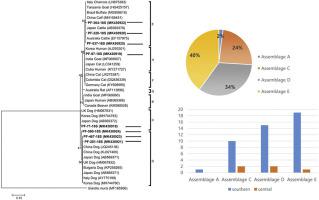Parasitology International ( IF 1.5 ) Pub Date : 2020-06-09 , DOI: 10.1016/j.parint.2020.102154 Haeseung Lee 1 , ByeongYeal Jung 2 , Jun-Sik Lim 3 , Min-Goo Seo 2 , Seung-Hun Lee 4 , Kwang-Ho Choi 2 , Mi-Hye Hwang 2 , Tae-Hwan Kim 1 , Oh-Deog Kwon 1 , Dongmi Kwak 5

|
Giardia duodenalis (syn. G. intestinalis, G. lamblia) is an important zoonotic parasite infecting livestock (including pigs) through ingesting cysts in contaminated food or water. This parasite has been classified into eight different genetic assemblages, A to H. Here, we examined the individual-level prevalence of G. duodenalis in domestic pig farms and confirmed host specificity by genotype comparisons. Samples were collected from southern and central Korea, between May 2017 and January 2019. DNA directly extracted from 745 pig fecal specimens were tested by PCR for G. duodenalis small subunit ribosomal RNA (ssu rRNA), glutamate dehydrogenase (gdh), and β-giardin gene sequences. Based on ssu rRNA PCR, 110 (14.8%) were positive for G. duodenalis. Infection risk was the highest in the fattener group (31/139, 22.3%) and during the autumn season (52/245, 21.2%: p < .001). No statistically significant differences in risk for infection were observed between fecal types (normal versus diarrheal). Fifty ssu rRNA samples, three gdh samples, and five β-giardin samples were successfully sequenced and genotyped. Ssu rRNA assemblage sequence analysis identified E (40.0%, 20/50), D (34.0%, 17/50), C (24.0%, 12/50), and A (2.0%, 1/50). The gdh locus identified three samples as assemblage E, and the β-giardin locus identified four samples as assemblage E and one as assemblage C. Assemblage A sequences obtained (ssu rRNA; MK430919) had 100% identity with Giardia sequences isolated from a Korean individual (AJ293301), indicating the potential of zoonotic transmission. Continuous management and monitoring for prevention of transmission and protection of animal and human health are essential.
中文翻译:

韩国猪鞭毛贾第鞭毛虫的多基因座基因分型。
贾第鞭毛虫duodenalis(同义词G.肠,贾第虫)是一种重要的人畜共患寄生虫感染家畜(包括猪)通过摄取受污染的食物或水囊肿。此寄生虫已分类为8种不同的遗传组合,从A到H。在这里,我们检查了家养猪场中十二指肠球菌的个体水平患病率,并通过基因型比较确认了宿主特异性。在2017年5月至2019年1月之间,从韩国南部和中部收集了样本。通过PCR检测了从745头猪粪标本中直接提取的DNA,以检测十二指肠小亚基核糖体RNA(ssu rRNA),谷氨酸脱氢酶(gdh)和β-贾第素基因序列。根据ssu rRNA PCR,十二指肠球菌阳性110例(14.8%)。在增脂剂组中,感染风险最高(31 / 139,22.3%),而在秋季(52 / 245,21.2%:p <.001)。在粪便类型之间(正常与腹泻),未观察到感染风险的统计学显着差异。成功地对50个ssu rRNA样品,三个gdh样品和五个β-giardin样品进行了测序和基因分型。Ssu rRNA组装序列分析确定为E(40.0%,20/50),D(34.0%,17/50),C(24.0%,12/50)和A(2.0%,1/50)。该GDH轨迹确定了三个样本作为集合E,以及β-giardin轨迹确定了四个样本作为集合E和获得的一个作为集合C.缝合- A序列(SSU rRNA基因; MK430919)是具有与100%的同一性贾第虫从韩国个体分离的序列(AJ293301 ),表明人畜共患病的传播潜力。持续管理和监测对于预防传播和保护动物及人类健康至关重要。











































 京公网安备 11010802027423号
京公网安备 11010802027423号